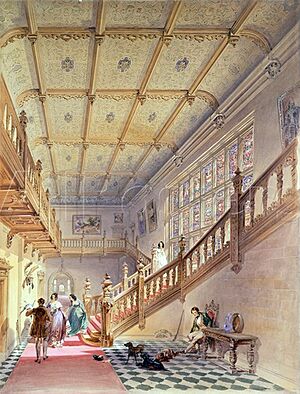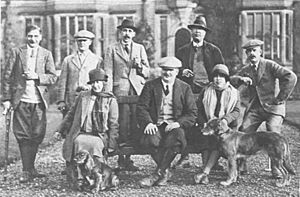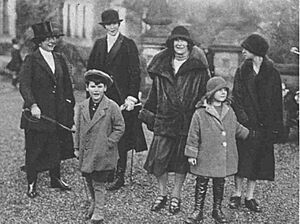Beaumanor Hall facts for kids
Beaumanor Hall is a grand old house with a large park in the village of Woodhouse, England. It's close to Loughborough in Leicestershire. The beautiful building you see today was built between 1842 and 1848. It was designed by architect William Railton for the Herrick family. Before this, other houses stood on the same spot, dating back to the 1300s! Beaumanor Hall is a very important historic building. During the Second World War, it played a secret role in military intelligence. Today, Leicestershire County Council owns it. It's used as a place for training, conferences, and even as a residential centre for young people.
Contents
Beaumanor Hall: A Long History
The land where Beaumanor Hall stands has a long and interesting past. After the Norman Conquest, a powerful lord named Hugh d'Avranches owned it. Later, in the 1200s, the Despenser family took over. They created a deer park and built a hunting lodge here.
In 1327, the land went to Henry de Beaumont. He built a new house called Beau Manor in 1330. He also had the nearby church built. This house was later replaced in 1595 by Sir William Herrick. He was an important government official for Queen Elizabeth I.
The house was changed a lot around 1610. It stood until 1725 when a smaller house was built. This third house was pulled down in 1842. Then, the current grand hall was built for William Herrick. It took seven years, from 1842 to 1848. The stone for the hall came from quarries in Derbyshire.
The Herrick Family at Beaumanor
William Perry Herrick (1794 – 1876) was the person who built the current Beaumanor Hall. He became very wealthy after inheriting properties from his uncle. William lived at Beaumanor with his younger sister, Mary Ann Herrick (1796-1871).
Mary Ann was known for being very generous. She gave money to many good causes. For example, she helped build almshouses (homes for poor people) in Woodhouse in 1856. She also helped build a schoolmaster's house and an infant school. William also gave money to the church. In 1872, he paid for St Marks Church in Leicester.
In 1862, William married Sophia Christie (1831-1915). She was much younger than him. They did not have any children. After William died in 1876, Sophia managed the Beaumanor estate for 40 years. People liked her very much. When Sophia died in 1915, Beaumanor was inherited by William's relative, Montagu Curzon. He then added "Herrick" to his name.
William Montagu Curzon Herrick (1891-1945) was the next owner. He married Maud Kathleen Cairns Plantagenet Hastings, known as Kathleen. She was the daughter of a famous Earl.
A big wedding took place at Beaumanor in 1923. It was between Dorothy Hastings, Kathleen's cousin, and Lord Eltham. He was the Queen's nephew! Newspapers wrote all about the grand event. The bride wore a cream satin dress with a long train. Her veil was a family treasure. The bridesmaids wore powder blue satin with silver lace.
William and Kathleen often hosted fun house parties at Beaumanor. One of these parties from 1926 is shown in the photographs.
The Herrick family owned Beaumanor Hall until 1939. The estate was huge, with the hall and 6,500 acres of land. This included farms, hills, a church, and many houses.
Beaumanor Hall During World War II
In 1939, just before the Second World War started, the War Office took over Beaumanor Hall. The park became a secret listening station. Here, skilled people intercepted secret enemy signals. These signals were often in Morse code. The messages were then sent to the famous Station X at Bletchley Park. They were sent by motorcycle every day to be decoded. Beaumanor Park was home to the War Office ‘Y’ Group throughout the war.
After the war ended in 1945, the estate went back to the Herrick family. But because of financial reasons, the family decided to sell it. In 1946, the War Office bought Beaumanor Hall and some of the land used during the war.
A Secret Training Centre
From 1939, Beaumanor Hall was used by Number 6 Intelligence School. The rooms inside the hall became a training centre. People from the Post Office, Civil Service, and Merchant Navy were trained here. Soldiers from the Royal Corps of Signals, Royal Navy, and Royal Air Force also trained inside the hall.
The huge cellars under the building were used as workshops for electricians. The stables and other buildings around the hall also became workshops. These housed people who set up antennas, fixed vehicles, and worked on instruments.
By late 1941, many Navy and Air Force staff had moved to other listening stations. The main part of the site became home to the Royal Signals. Military staff continued to train inside the hall until the war ended. In February 1942, the first women from the Auxiliary Territorial Service (ATS) arrived. They were housed in nearby villages.
Beaumanor became one of the most important "Y stations." These stations intercepted enemy radio messages. They then sent the information to "Station X" at Bletchley Park. There, the messages were decrypted and studied. It is known that Beaumanor received one of the first confirmations of the successful Operation Chastise mission. This was the famous "Dambusters" raid.
By 1943, a special room on the top floor was used for "Radio fingerprinting." This new technology could identify the exact radio set sending a message. Special machines filmed the signals. Then, the signals were compared to find out who was sending them.
The room next door kept records of where the signals came from. This was called the Radio Direction Finding room.
In 1940, special wireless set rooms were built in the grounds of the hall. This was instead of changing the rooms inside the building. A field to the north of the hall was chosen for these new "huts."
In the mid-1970s, Leicestershire County Council bought the hall. It quickly became a busy centre for conferences and education.
The Secret Huts
The War Office Y Group had an architect who worked at Beaumanor. He designed the special "set rooms" and other buildings. These buildings were disguised to look like normal farm buildings. This disguise was unique to Beaumanor. No other military buildings during the war were hidden in this way.
A large field to the north of the hall was chosen for the huts. The huts were spaced far apart. This was to prevent too much damage if there was a bombing raid. Each hut was made of brick with strong blast walls. Then, a disguised outer covering was added.
The huts were hidden in different ways:
- One looked like a cart shed with a barn (Hut J).
- Two looked like small cottages (Huts H and I).
- Another looked like stables (Hut K).
- The fifth was disguised as a glasshouse (Hut M).
- The sixth, Hut G, looked like a cricket pavilion with a fake clock tower.
Each hut was given a letter of the alphabet. The four huts around the edge of the field were H, I, J, and K. These huts held the wireless receivers for intercepting messages. All the cables and antenna wires were hidden underground. Each hut had a special tube system. This system sent handwritten messages to Hut G using a cylinder that shot through the tube. This tube system was also hidden underground.
Other huts were hidden in the wooded area behind the hall. These huts had wooden exteriors. They were lettered A, B, C, D, E, and F.
The people who listened to the wireless messages were women from the ATS. They had been trained on the Isle of Man. They intercepted German and Italian messages. Many of these messages were coded using Enigma machines. This was very difficult work because the codes made it impossible to guess what was being said. Once the messages were gathered, they were sent by motorcycle to Bletchley Park to be decoded. The women who worked at Beaumanor were known as the WOYGians.
Images for kids








